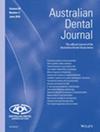Influence of patient demographics and socio-economic status on treatment choices for permanent mature teeth with painful vital teeth: a pilot study in the Australian public dental system
Abstract
Introduction
Socio-economic status influences treatment decisions. This influence remains uncovered in teeth with painful pulpitis.
Aims
To investigate the influence of patients' demographics and socio-economic status on treatment choices for permanent mature teeth with painful vital teeth.
Methods
Records of adult patients who received extraction, root canal treatment and vital pulp therapy in public sector dental care were categorized. Correlation of patient age, gender and socio-economic status with rendered treatments was investigated. Patients' socio-economic status was determined using their postcode's Socio-Economic Indices for Areas (SEIFA) scores; a high score indicates higher status. Three groups of n = 25 patients per treatment were randomly selected after applying the inclusion criteria. Data were analysed using chi-square test, One-way ANOVA and Kruskal–Wallis test.
Results
There was no significant correlation between patient age or gender and treatment performed (P = 0.250, P = 0.683). SEIFA scores were higher for vital pulp therapy, then root canal treatments and lowest for extraction; however, no significant association existed between patients' socio-economic status and treatment type (P = 0.210). A formal diagnosis was not documented in 8% of vital pulp therapies, 28% of root canal treatments, and 64% of extraction cases. Vital pulp therapy was never offered in root canal treatment or extraction groups. Pulp exposure guided vital pulp treatments, while patient preference drove half of root canal treatment and extraction choices.
Conclusions
Patients age and gender did not affect treatment decisions. Socio-economic status might influence treatment decisions in painful permanent teeth. The service setting appears to have a major impact.


 求助内容:
求助内容: 应助结果提醒方式:
应助结果提醒方式:


